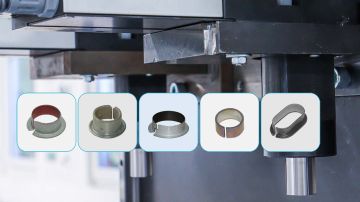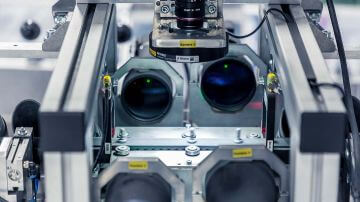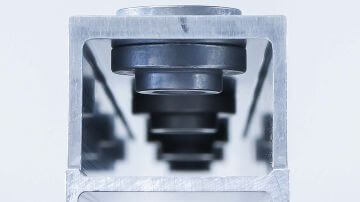
Plain bearing bushing
as an effective solution for low-wear movements
Blog post | october 2, 2023
Plain bearings are essential to the industrial world, ensuring the smooth running of machinery and minimizing wear. They are easy to install and play a significant role in reducing maintenance costs. Slide bearing bushings are available in a range of sizes, shapes and materials to meet the specific needs of different industries. In the first part of this article, we dive into the basics of the plain bearing bush. In the second part, we explain the automated assembly of bearing bushings under the press and highlight the many benefits it offers.
Contact us
Our customer service will help you with any questions!
Contents
- Functions and tasks of the plain bearing bushing
- Shapes and sizes of the slide bushing
- Materials of the bearing bushing
- Coatings of the slide bushing
- Applications of the plain bearing bushing
- Automated assembly under the press
- Advantages of automated assembly
- Selection of the right bearing bushing
- Summary

Functions and tasks of the plain bearing bushing
The plain bearing bushing is a cylindrical or tapered element that is fitted into an opening or housing. In most cases, the interior of the bushing is designed to fit snugly around the outer surface of the moving component that passes through the bushing. The slide bearing consists of a sleeve with a smooth surface. This allows the sliding component to move easily with little friction.
Primarily, plain bearing bushings are used in machine and vehicle parts to reduce friction between two moving components. They make this possible by serving as an intermediate layer. The low friction results in higher efficiency and less energy loss.
The bushings are also capable of supporting high loads. They can distribute the pressure generated by the load over their entire surface. This makes them ideal for applications where high loads occur.
Plain bushings help minimize wear on machine parts. They protect parts from direct contact, which can extend the life of the machine. The bushings help dissipate heat generated by friction, preventing overheating of machine parts. They have good thermal conductivity, which helps keep the temperature in the bearing low. They also absorb vibrations and shocks that may occur during the operation of a machine and provide smoother operation.
Shapes and sizes of the slide bushing
There are several types of plain bearings, including bushings, flanges and strips. Bushings are the most commonly used plain bearings and have a cylindrical shape. The cylindrical plain bearing bushing is often used in linear motion applications and is best suited for radial loads. The flanged bearing bushing has a flange on one end that helps support the load and hold the bearings in place. It handles both radial and axial loads. The strip bearing comes in strip form and can be cut to the size needed.
The size of the bearing bushing varies depending on the application and can be available in many different dimensions. The inner diameter is the diameter of the opening in the bushing where the shaft is placed. The outside diameter is the overall diameter of the bushing. These sizes can range from a few millimeters to several centimeters, depending on the size of the shaft. The length of the bushing and the wall thickness are also chosen depending on the loads to which the bushing will be subjected, among other factors.

Materials of the bearing bushing
Bronze
Plain bearing bushes made of bronze offer high load capacity and excellent wear resistance. As a material for slide bushings, bronze is most suitable due to its excellent sliding properties and corrosion resistance. There are various types of bronze used, such as tin bronze, aluminum bronze and lead bronze. Bronze bearings are used in automotive, marine and industrial machinery. They are suitable for high load and high temperature applications. In engines, they are used for connecting rod bearings and crankshaft bearings, and in turbines and generators to support high speeds and loads. In ships, they are used in the ship's shaft to allow low-friction rotation of the shaft.
Steel
Bearing bushes made of steel are used when high loads and temperatures are expected. Bushings can be finished with various coatings that further improve their sliding properties and corrosion resistance. Carbon steel is a cost-effective option for slide bearings. However, this steel can corrode if not properly treated. Alloy steel is more durable than carbon steel and is often used in heavy-duty applications. Another commonly used steel grade is case-hardened steel, which offers good wear resistance.
Stainless steel is best suited as a material for sliding bushings because of its high resistance to corrosion and wear, as well as its high load-carrying capacity. However, stainless steel is more expensive than other materials and is therefore only used in special applications where its specific properties are indispensable. Stainless steel plain bearings are often used in environments with high humidity or corrosion. In the food, beverage and pharmaceutical industries, they are used because of their ease of cleaning and resistance to detergents. In the automotive industry, they are preferred because of their high load-carrying capacity and good thermal conductivity.
Sintered metals
Bushings made of sintered materials are maintenance-free because they have self-lubricating properties. During sintering, the bushings are formed under high temperatures and oil or lubricants are introduced into the pores of the material. When the bearing is in operation, frictional heat causes it to release the lubricant, providing continuous lubrication. The result is constant lubrication that increases bearing life and eliminates the need for regular relubrication. This feature makes sintered bearings a cost-effective and efficient solution for many industrial applications.
Sintered bronze bearings are made of porous bronze and can store oil or grease, making them ideal for applications where lubrication is difficult to manage.
In medical devices such as pacemakers and artificial joints, bearing bushes made of sintered metals are used because of their high precision and good biocompatibility. Due to their high wear resistance, they are used in power tools such as drills, grinders and saws, as well as in industrial machinery such as printing machines, packaging machines and textile machines.
Composite materials
Composite bushings combine several materials. These bearing bushings often have a metal housing and a plastic, ceramic or bronze inner ring. The use of composite materials allows for high load capacity, wear resistance, improved heat dissipation and corrosion resistance, making them the optimal choice for applications with demanding operating conditions and high loads.
Plastics
Plastic bearing bushings are preferred in applications that require light weight, corrosion resistance and low friction. Plastics are low maintenance and offer good chemical resistance. They are well-suited for applications with short movement sequences at low speeds, such as in household appliances. Plastic bushings are used in the food industry because of their resistance to detergents and food fastness, and in the textile industry because of their resistance to chemicals. In medical technology, they are used because of their good sliding properties, such as in joints of prostheses.
Plain bearing bushings made of PTFE offer excellent sliding properties and high chemical resistance. This plastic is also very temperature resistant. Such bushings are often used in chemical process equipment, pumps and valves. Polyamide (PA) is another plastic commonly used for slide bearings, due to its high wear resistance and good sliding properties. In the automotive industry, PA bearing bushings are used, for example, in hinges, shock absorbers and other parts that require high load capacity. They are used in electric motors and generators due to their good electrical insulation properties. They are also used in packaging and filling machines due to their good chemical resistance and food fastness.
Ceramic
Ceramic bearings are often used in extreme environments. Ceramic bearings are suitable for applications where conventional bearing materials reach their limits. Ceramic slide bearings are extremely hard and wear resistant. They are resistant to corrosion and high temperatures. They are therefore particularly well suited for use at high speeds, speeds and loads, such as in high-speed engines and turbines.
Coatings of the slide bushing
Bearing bushings are available with various coatings that have specific properties and can further improve the performance of the bushings. One common coating is zinc. Zinc coatings, such as the zinc-nickel coating, provide good corrosion protection and are inexpensive. Another common coating is copper. Copper has excellent thermal properties and can improve heat dissipation. It can also increase wear resistance and reduce friction. Tin is a soft metal that offers good corrosion resistance and is often used as a lubricant. It can improve the friction performance and extend the service life of the bushings.
For applications requiring high wear resistance, a bronze or steel coating is often used. Coatings made of plastic are also common, as they can have self-lubricating properties. Teflon coating (PTFE) reduces friction and improves sliding properties. It is also chemically resistant and can be used in harsh environments. The molybdenum disulfide coating improves lubrication. The DLC (Diamond-Like Carbon) coating provides extremely high surface hardness and thus high wear resistance.

Applications of the plain bearing bushing
Plain bearings are ideal for applications where high loads and slow rotary motion occur, such as in wind turbines, bridges, marine propulsion systems and industrial machinery. They are used in many industries:
Automotive industry
Slide bearing bushings can be used in the seat structural parts to improve the comfort and durability of the seat. They can be used in the seat frames, seat adjusters and seat backs. In the seat tracks and adjusters, they enable smooth and frictionless movement of the seat, as well as precise adjustment of the seat position and tilt. In the seat structural parts, the bushings also help reduce the noise level generated by the movement of metal parts. Due to their high load capacity and resistance to wear and fatigue, they ensure the longevity of the seat mechanisms.
Plain bearing bushings are especially useful in areas where high stress and friction can occur, such as the hinges of car doors, hoods, liftgates and trunks. The bushings allow the hinges to move efficiently. They help reduce friction between the metal parts of the hinge, resulting in less wear and tear and a longer life for the hinge. Again, the slide bushing can help reduce the noise of the hinge's movement. This leads to a more pleasant driving experience and helps reduce the overall noise level in the vehicle.
Plain bushings are important components in articulated parts of vehicles. In steering and suspension systems, they enable smooth and precise control. They are also used in axles, wheel suspensions and steering columns. Here, the plain bushings also help dissipate heat and extend the life of the joints. They ensure even weight distribution and help reduce vibration and noise, resulting in a better ride quality.
Mechanical engineering
In pumps, compressors and turbines, slide bearing bushings support rotating parts and facilitate shaft rotation. They are used in a variety of industrial machinery, to support moving parts.
They are also found in agricultural machinery such as tractors and harvesters, and in construction machinery with excavators and cranes. In rail vehicles, they support the axles. In the construction industry, they enable movements in bridges and buildings.
Aerospace
Plain bearing bushings are used in aircraft engines, to support rotating parts in the engine. In aircraft landing gear, they support moving parts such as wheels and shock absorbers. They are used in the joints of structural components, such as aircraft wings and spacecraft booms. In control systems, bearing bushings allow movement of control rods and other mechanical linkages. They are also used in the joints of solar cell arrays and in the boom mechanisms of satellite antennas.
Wind energy
In the generators of wind turbines, slide bearing bushings are used to support the rotating parts. The rotor of a wind turbine, which rotates around an axis, is equipped with bearing bushings. In the gearbox of a wind turbine, the plain bearings ensure efficient movement of the individual gear elements. The nacelle of a wind turbine can rotate around the tower axis to position itself optimally into the wind. Slide bushings are also used here.
Electronics
In electronic devices, plain bushings reduce friction between moving parts. They are used in electric motors, fans and other mechanical components that produce rotary motion. In fans, they ensure that the rotor blades rotate smoothly and quietly. They are also used in mechanical keyboards, optical drives and printers.
Household appliances
In drums of washing machines, slide bushings enable smooth rotation. They are used in rotating spray arms of dishwashers, for even distribution of water. They are also used in condensers of refrigerators. They are used in moving parts of food processors, such as blenders, mixers or juicers. In electric toothbrushes, they enable the brush head to vibrate.

Automated assembly under the press
Automated assembly of plain bearing bushes is achieved by using automated assembly systems such as the setting head for press tools. The setting head is installed directly in the press tool.
The assembly process begins with an automatic feeding system that conveys the plain bearing bushes to the setting unit. The setting head presses the bushings into the workpieces and flanges them.
The press movement actuates the press-in mandrel of the setting head, which transmits the press force. This presses the bushing into the component. The slide bearing bushing is assembled in two work steps. In the first step, which takes place simultaneously with the insertion of the bushing, the plain bushing is bent through 45 degrees. Here, the punching head precisely positions the bearing bushing in the component while the pre-flanging module folds over the upper edge.
A flanging tool is placed on the edge of the bushing and then pressed down with force. This deforms the material of the bushing and presses it against the wall of the pilot hole in the component, holding the collar bushing in place.
In one of the next tool stations is the end flanging module, which flanges the bushing to 90 degrees and simultaneously calibrates the inner diameter. This ensures exact repeatability of the flanging process. The flanging of plain bearing bushings not only serves to stiffen the collar bushings, but also creates a second sliding surface on the flanged side and secures it in the component.
After assembly, a presence control of the bushing takes place. The presence control verifies that the collar bushing is present in the component.

Advantages of automated assembly
Automated assembly of plain bearing bushes under the press offers many advantages. First, it increases production speed, as the manufacturing process continues without interruption. It speeds up production and increases efficiency, as the assembly systems can work around the clock. With precise settings, automated manufacturing reduces human error, improving product quality.
In addition, production costs are reduced because there is less manual labor. Automation also minimizes the physical strain on employees and ensures occupational safety. In addition, it enables consistent and continuous production, which leads to an increase in productivity.
Ultimately, automation can achieve higher utilization of the press, which significantly increases efficiency. Finally, automated assembly is more environmentally friendly as it produces less waste.
The complete processing of the plain bearing bushing in the die also means that no storage is necessary between the individual work steps. This therefore reduces storage and logistics costs. All processing steps are carried out directly in the tool. This means that no downstream operation is required.

Selection of the right bearing bushing
When selecting the right bearing bushing, some basic criteria should be considered. The size and shape of the bushing must be considered in the design and fit the component in which it will be used. It is important to accurately determine the correct inner and outer diameters and length of the bushing.
The bearing bushing should be made of a material that meets the requirements of the application. The choice of material depends heavily on specific requirements, such as load capacity, ambient temperature and required durability. At high speeds or loads, certain materials can fail or wear out quickly. If the bearing bushing will be used in an environment with high temperatures, corrosion or other harsh conditions, it should be made of a material that can withstand these conditions.
It is important to note that material selection also affects the need for lubrication. The choice of the right material for a plain bushing can affect the need for lubrication.
Cost can also be a consideration. While higher quality bearing bushings tend to be more expensive, they can be more cost effective in the long run if they last longer and require less maintenance. Some bushings require regular maintenance, while others are maintenance-free. The choice depends on how much maintenance is acceptable.
Summary
In summary, plain bearings are an indispensable component in industry. They provide reliable and efficient solutions in a wide range of applications, from the automotive industry to household appliances. Plain bearing bushings reduce friction, improve energy efficiency and are often the preferred choice due to their durability and low maintenance. They play a crucial role in maintaining smooth operation.
Automated assembly of plain bearing bushes under the press has proven to be efficient and reliable. It increases production speed and minimizes errors, resulting in improved overall product quality. By using effective technologies, assembly processes can be optimized and resources used more efficiently. Despite initial investments in automation technology, they pay off in the long run through increased productivity and quality. It is therefore advisable to pursue this path of automation.



